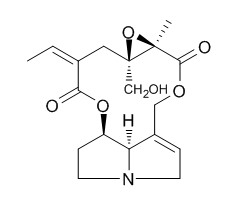Erucifoline
Erucifoline and Jacobine are feeding deterrents and toxic compounds against insect herbivores.
Inquire / Order:
manager@chemfaces.com
Technical Inquiries:
service@chemfaces.com
Tel:
+86-27-84237783
Fax:
+86-27-84254680
Address:
1 Building, No. 83, CheCheng Rd., Wuhan Economic and Technological Development Zone, Wuhan, Hubei 430056, PRC
Providing storage is as stated on the product vial and the vial is kept tightly sealed, the product can be stored for up to
24 months(2-8C).
Wherever possible, you should prepare and use solutions on the same day. However, if you need to make up stock solutions in advance, we recommend that you store the solution as aliquots in tightly sealed vials at -20C. Generally, these will be useable for up to two weeks. Before use, and prior to opening the vial we recommend that you allow your product to equilibrate to room temperature for at least 1 hour.
Need more advice on solubility, usage and handling? Please email to: service@chemfaces.com
The packaging of the product may have turned upside down during transportation, resulting in the natural compounds adhering to the neck or cap of the vial. take the vial out of its packaging and gently shake to let the compounds fall to the bottom of the vial. for liquid products, centrifuge at 200-500 RPM to gather the liquid at the bottom of the vial. try to avoid loss or contamination during handling.
Revista Brasileira de Farmacognosia2024, 34:1276-1286.
Evid Based Complement Alternat Med.2021, 2021:6687513.
Lab Chip.2018, 18(6):971-978
Curr Issues Mol Biol.2022, 44(5):2300-2308.
J Liq Chromatogr R T2025, 2505536.
J Chromatogr B Analyt Technol Biomed Life Sci.2022, 1203:123307.
Molecules.2020, 25(21):5091.
Int J Mol Sci.2017, 18(12)
Molecules.2019, 24(17):E3127
Molecules.2023, 28(4):1785.
Related and Featured Products
J Chem Ecol. 2014 Jun;40(6):609-16.
Toxicity of pyrrolizidine alkaloids to Spodoptera exigua using insect cell lines and injection bioassays.[Pubmed:
24981118]
METHODS AND RESULTS:
Pyrrolizidine alkaloids (PAs) are feeding deterrents and toxic compounds to generalist herbivores. Among the PAs of Jacobaea vulgaris Gaertn, jacobine and Erucifoline are the most effective against insect herbivores as indicated by correlative studies.
Because little is known about the effect of jacobine and Erucifoline as individual PAs, we isolated these compounds from their respective Jacobaea chemotypes. These PAs and other commercially available senecionine-like PAs, including senecionine, seneciphylline, retrorsine, and senkirkine, were tested as free base and N-oxide forms at a range of 0-70 ppm. Feeding bioassays using live insects are closer to the natural pattern but require relatively large amounts of test compounds. We, therefore, compared the toxicity of PAs using both Spodoptera exigua cell line and larval injection bioassays. Both bioassays led to similar results in the order of PA toxicity, indicating that the cell lines are a valuable tool for a first toxicity screen. Testing individual PAs, jacobine and Erucifoline were the most toxic PAs, suggesting their major role in plant defense against generalist herbivores.
CONCLUSIONS:
Senkirkine and seneciphylline were less toxic than jacobine and Erucifoline but more toxic than retrorsine. Senecionine was not toxic at the tested concentrations. For all toxic PAs, the free base form was more toxic than the N-oxide form. Our results demonstrate that structural variation of PAs influences their effectiveness in plant defense.
Phytochemistry. 2004 Apr;65(7):865-73.
Variation in pyrrolizidine alkaloid patterns of Senecio jacobaea.[Pubmed:
15081286]
We studied the variation in pyrrolizidine alkaloid (PA) patterns of lab-grown vegetative plants of 11 European Senecio jacobaea populations.
METHODS AND RESULTS:
Plants were classified as jacobine, Erucifoline, mixed or senecionine chemotypes based on presence and absence of the PAs jacobine or Erucifoline. Due to the presence of jacobine, total PA concentration in jacobine chemotypes was higher than in Erucifoline chemotypes. Both relative and absolute concentrations of individual PAs differed between half-sib and clonal families, which showed that variation in PA patterns had a genetic basis.
CONCLUSIONS:
Within most populations relative abundance of PAs varied considerably between individual plants. Most populations consisted either of the jacobine chemotype or of the Erucifoline chemotype, sometimes in combination with mixed or senecionine chemotypes.



